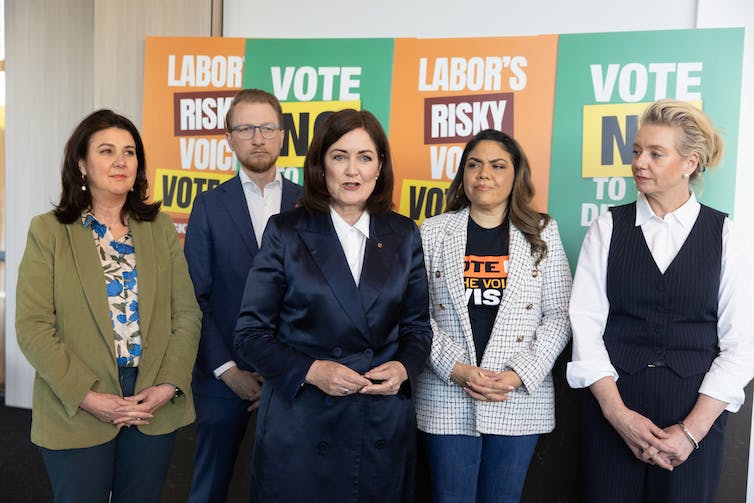The academic study of public opinion is a well-developed area. One foundational finding is that while the views of voters often seem contradictory and incoherent, these apparent inconsistencies have a pattern.
The views that voters express in opinion polls reveal that many voters, especially those disengaged from politics, understand key concepts such as “equality” and “disadvantage” in a very different way from political elites of both left and right.
The fact that public opinion does not align with traditional “left” and “right” viewpoints means that both progressives and conservatives have opportunities to gain majority support. The marriage equality plebiscite dashed conservatives’ dreams of a suburban “silent majority”. The Voice referendum seems likely to be disappointing for the left. The dynamics of both ballots are similar.
One key finding from the study of popular ideology is that voters often express loyalty to general principles while also supporting policies that contradict those principles.
Often these general principles are conservative. For example, Americans worry about government being too large, but when questioned about specific government programs, will support their extension.
New polling shows ‘no’ voters more likely to see Australia as already divided
Australians have very high levels of patriotism, but most are not aggressive nationalists. There are some left-wing general principles that attract strong majority support, such as equal opportunity and that immigration contributes to cultural enrichment. However, voters’ interpretation of these principles is not a left-wing one: affirmative action for women is very unpopular, and although voters support multiculturalism as an aspiration, they are much more doubtful about immigrant communities receiving government assistance to maintain culture and traditions.
Many aspects of the history of public opinion about Indigenous affairs, as chronicled in Murray Goot and Tim Rowse’s 2007 book Divided Nation, are consistent with this pattern. The political right is often more divided on policy than the left, but it has been successful in maintaining a coalition based on an appeal to abstract principles. The success of the “no” campaign is a case in point.
In a liberal democracy, “equality” is a powerful idea, but its meaning is contested. From the 19th century, conservatives found to their surprise that formal political equality did not mean the disappearance of the social and economic inequalities they cherished. Conservatives have mostly championed formal political equality.
Diego Fidele/AAP
The campaign against the Voice has centred themes of equality against the special treatment of Indigenous people. The theme is almost 50 years old, going back to mining industry campaigns against land rights in the 1970s.
However, the idea of equality is also a tool against institutionalised racism. At the 1967 referendum, voters supported the idea of equality, even though the same voters rejected social closeness to Indigenous people and had a low opinion of their character and abilities.
Supporters of “yes” have complained of the invocation of racist themes by some “no” campaigners.
However, since the 1990s, public attitudes to Indigenous claims have shifted from hostility to mild support. But in an Australia less racist than it has ever been, the Voice now seems destined for defeat.
The question is why were progressives unable to propose a convincing counter-narrative? The fact that initially the Voice attracted strong support suggests this was not inevitable.
Although “equality” is a deeply popular idea, voters do not understand equality as simple sameness. In other words, they do not support a narrowly libertarian view that past history and current cultural differences have no bearing on the entitlements of contemporary Australians.
Australian society is no longer, if it ever was, dominated by a culture of sameness. Voters recognise the claims of identity and difference, but only to a limited extent. As Goot and Rowse show, settlers have recognised the distinctiveness of Indigenous people, but they tend to understand it as applying only to some groups: those defined as “tribal”, remote, distinctive in appearance and so on.
They show that public support for land rights was higher when beneficiaries were defined in this sense. Both left and right have cited the disadvantaged position of Indigenous people in arguments for and against the Voice. But voters’ support for Indigenous specific programs is based less of perceptions of disadvantage than Indigenous distinctiveness.
Voters are sympathetic to identity claims when they are understood as something innate about individuals. However, they are less sympathetic when they are understood as the assertion of a collective political project.
What kind of Australia will we wake up to if the Voice referendum is defeated on October 14?
Scott Morrison’s personal religiosity initially contributed to an image of authenticity that voters found attractive. But his attempt to grant legal privileges to religious schools in the form of exemptions from anti-discrimination legislation were unpopular.
The campaign for marriage equality appealed powerfully to ideas about the right to love.
Conservatives deviate from a libertarian script when they argue that the high number of Indigenous MPs means that that First Nations peoples are already represented, but this expresses the view of Indigeneity as a personal attribute rather than a political force.
The settler majority has come to accept Indigenous people as equal individual citizens of the nation-state. In some cases, they have supported special entitlements for some Indigenous people, rejecting a purely libertarian approach.
Early support for the Voice reflected this, but the decline in support for the Voice demonstrates settlers are resistant to the idea of Indigenous peoples as a collective subject entitled to a unified Voice. Australian democracy is not colour-blind, but it defines difference within a limited framework.




